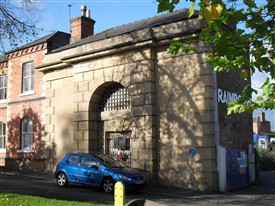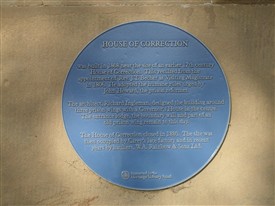The House of Correction at Southwell

The House of Correction today
Photographed October 2013

The blue plaque on the House of Correction today
The old House of Correction fronting onto Burgage Green in Southwell was erected in 1807/08, replacing an earlier building which had fallen into disrepair.
The new building was designed by the architect Richard Ingleman and was erected at a cost of £2112 on a site a little removed (around 80 yards) from the old prison, where previously had stood a brickyard.
Writing in 1818, R.P. Shilton in his History of Southwell records that the old prison was demolished and such materials as were still serviceable were incorporated into the new building 'down the road'.
The main frontage (pictured) was of Mansfield stone, "rusticated" says Shilton, "in the highest degree of workmanship..., [presenting] at once a face of solidity and elegance".
There then follows in Shilton's account, some fascinating details of the interior arrangements:-
"The entrance.... is into the lodge, which first presents a passage, or Turnkey's room; on the left hand is a room containing a bath, optionally hot or cold; a fumigating oven for the purification of infected garments; and a copper for the governor's use.
"On the right is another room for the Turnkey with a fireplace and staircase.
"On the second floor [ie the first floor to us] are two reception cells for prisoners, until they have been examined; or for those who arrive in the night; also a bedroom for the Turnkey..."
Behind the main reception building (pictured), 68ft along a flagstone walkway, stood the Governor's house, irregularly octagonal in shape, which also contained a chapel.
The chapel was for use by both staff and inmates, "wherein", notes Shilton, "the pews are admirably constructed for separation of the sexes".
Three "framed bridges" connected the chapel with the three wings of the prison, each of which radiated from one of the long sides of the Governor's house.
Herein male and female prisoners were kept strictly separated, and each ward had its own exercise yard with a stone bench and water trough in which the prisoners might wash.
From his house, the Governor overlooked each of the three wards and could see into all three yards - although, by an ingeniuos arrangement of wooden slats, the prisoners could not see him.
TEXT ON THE BLUE PLAQUE
The House of Correction was built in 1808 near the site of an earlier 17th century House of Correction. This resulted from the appointment of Rev. J.T. Becher as Visiting Magistrate in 1806. He adopted the humane rules urged by John Howard, the prison reformer.
The architect, Richard Ingleman, designed the building around three prison wings with a Governor's House in the centre. the entrance lodge, the boundary wall, and part of an old prison wing remain to this day.
The House of Correction closed in 1880. The site was then occupied by Carey's lace factory and in recent years by hauliers W.A. Rainbow & Sons Ltd.